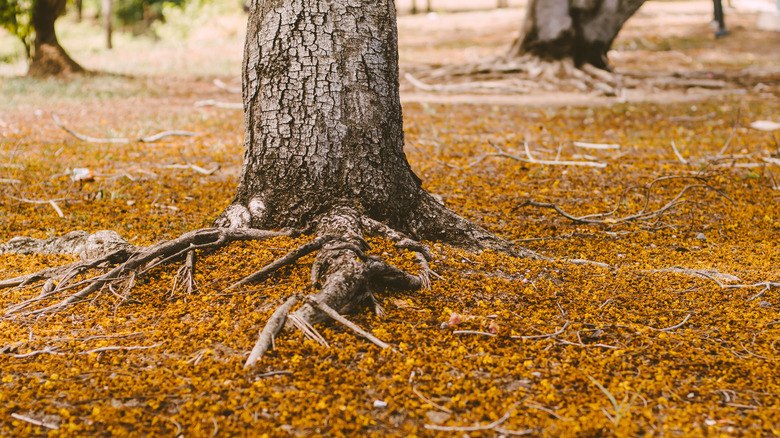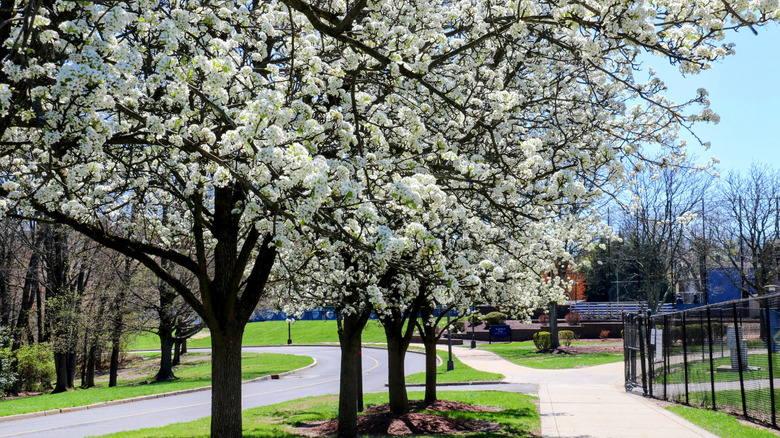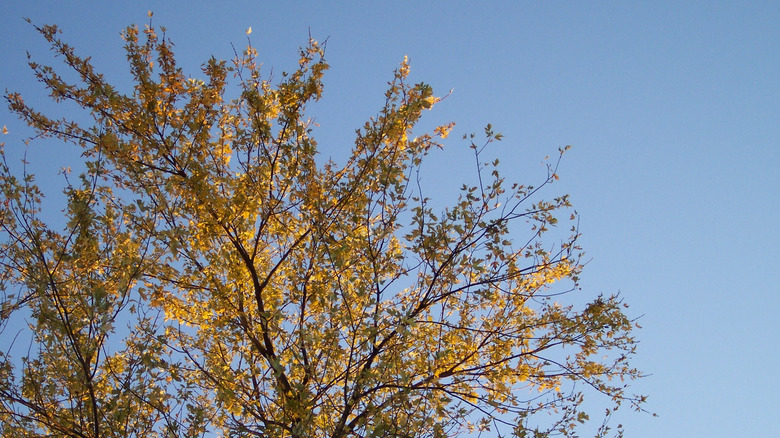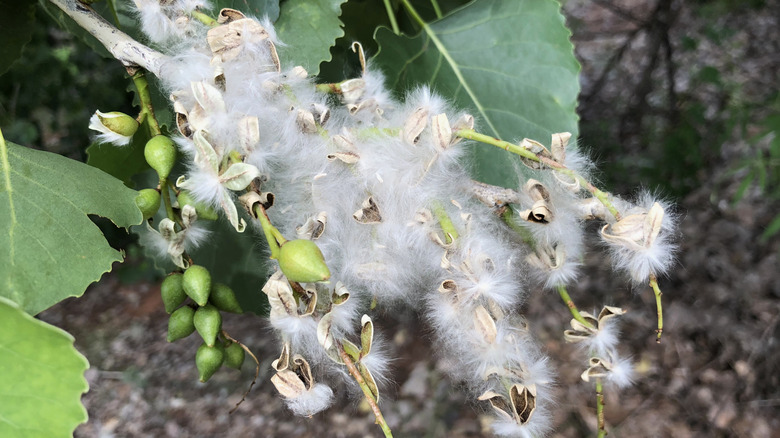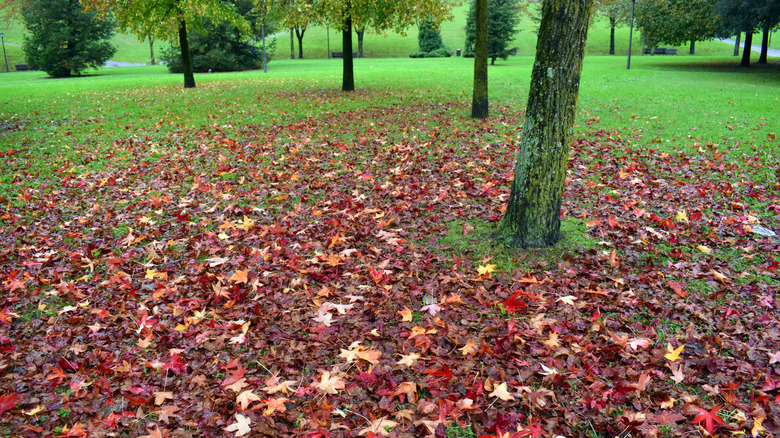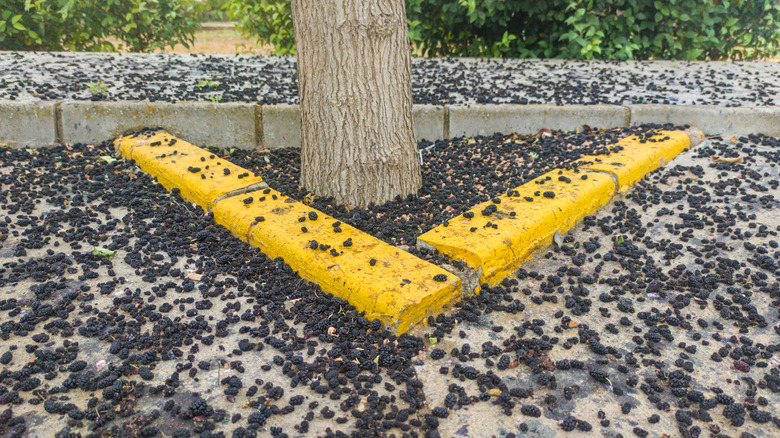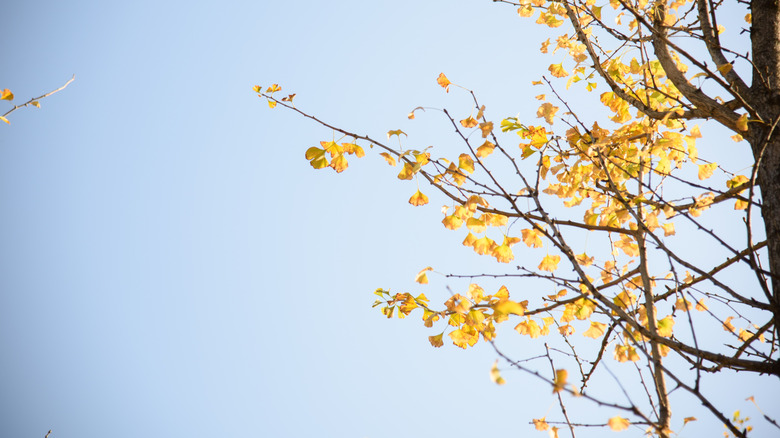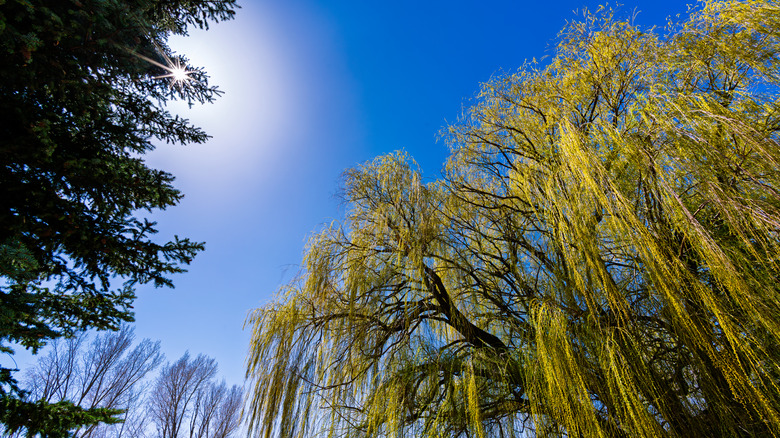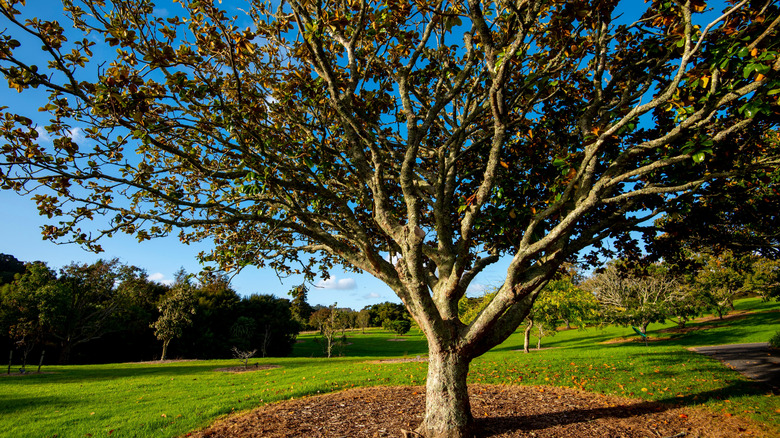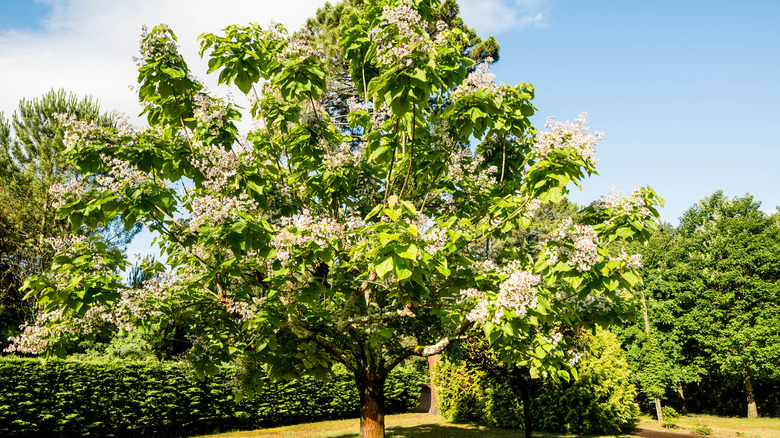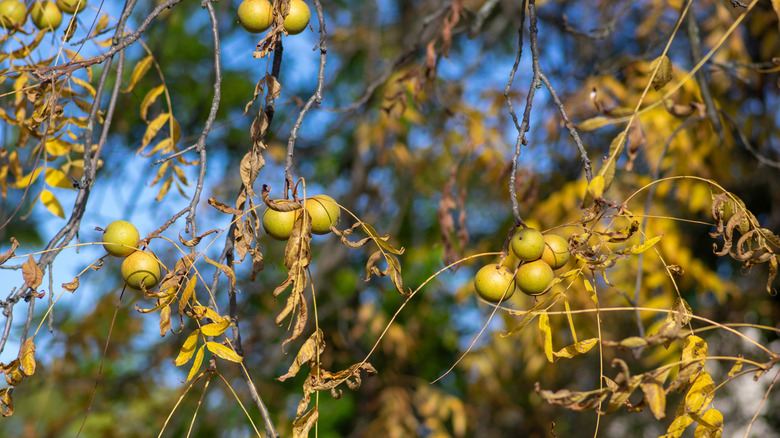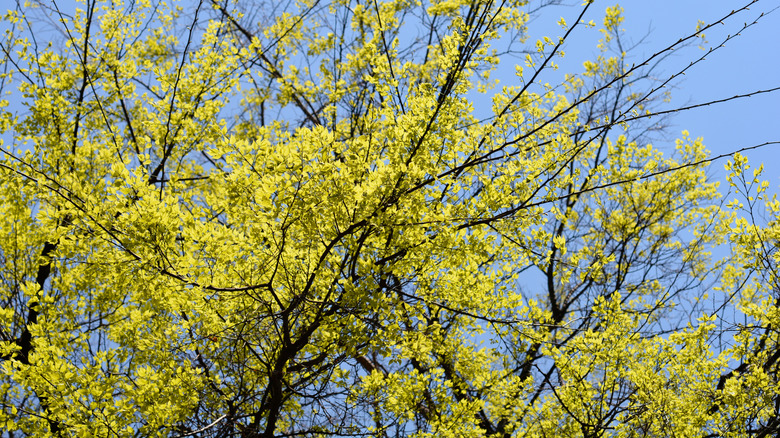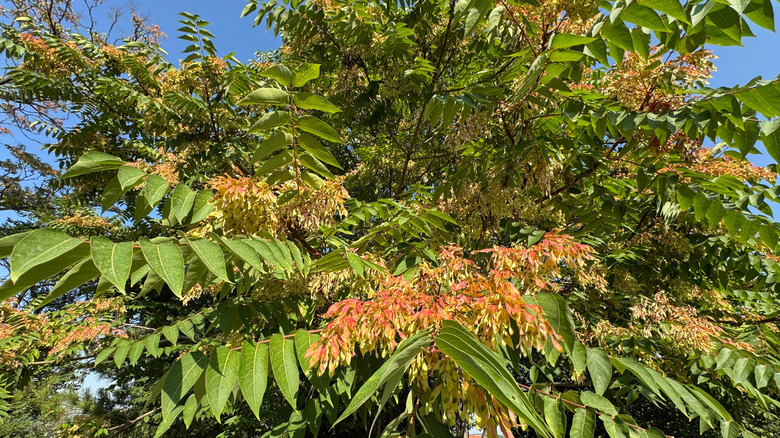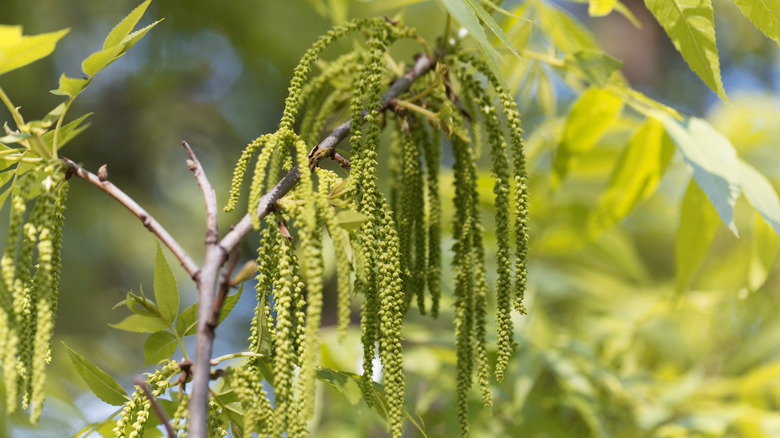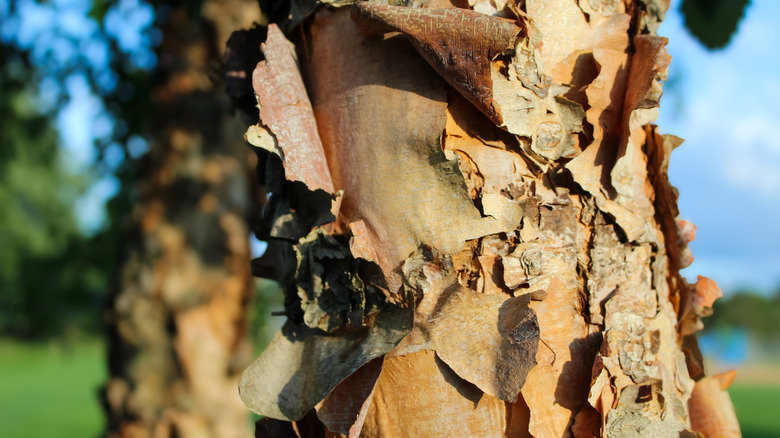The 14 Messiest Trees You Never Want To Plant In Your Yard
When it comes to selecting trees for a yard, homeowners mostly go for something that is easy to grow, adds a little bit of privacy or shade, and, obviously, looks nice. But what most people tend to overlook is the fact that some trees can turn a simple weekend yard cleaning task into an every day obligation. Take mulberries, for example. These trees look beautiful, no doubt about that, but when they drop fruit, purple stains appear everywhere, from the hood of your card to your kids' sneakers.
Black walnut trees are even worse. They spread their nuts everywhere, from your patio to your lawn, even wrecking a perfectly fine mower blades if you happen to go over one on an unlucky pass. And then there are cottonwoods, which top the list for messiness. They don't just shed — they explode. They will blanket your yard in seed fluff so thick that it will look like a pillow fight gone wrong. And this is just the mess you see. Some trees are often busy creating a mess underground.
Take, for example, silver maple. Their roots are notoriously famous for lifting sidewalks, buckling driveways, and creeping straight into sewer lines. This often leads to expensive repairs that no homeowner wants. So, think carefully before choosing the right tree for your yard so it doesn't end up ruining your plans for designing your own backyard like the pros.
Callery pear
Most people know the Callery pear (Pyrus calleryana) by its cultivar name, 'Bradford.' It grows fast and is resistant to many environmental stressors. Furthermore, it throws out a heavy load of white flowers right at the start of spring and, come fall, still looks pretty with its bold, fiery colors. However, it is invasive, weak, and its flowers have an unpleasant smell. Its weak branches are easily damaged by ice and wind, creating a mess in yards and roads and sometimes also resulting in utility outages. It is no longer recommended for planting by many extension services.
Silver maple
Silver maple (Acer saccharinum) is one of those trees that don't ask for much. It doesn't care where you plant it, whether it's an ideal garden soil or a reclaimed mining site. But people often plant it for shade near patios, for filling in large spaces, or as a natural screen. So, what's the catch? Well, it has a very robust root system that grows close to the surface of the ground and is often responsible for breaking sidewalks and clogging sewer pipes. The shallow root system also creates problems when it comes to mowing.
Eastern cottonwood
Eastern cottonwood (Populus deltoides) grows fast, adding as much as 8 feet a year and topping out at 100 feet tall and 70 feet wide. The plant is especially appealing to wildlife enthusiasts as it attracts various small mammals, birds, and butterflies. However, you don't want to plant a female eastern cottonwood. It produces a ton of white cottony fluff that is often immensely messy. Their prolific seeds spread far and wide, with this cottony stuff making it weedy. Also, its wood is quite weak, and branches will fall in windy conditions, creating cleanliness and safety issues.
Sweetgum
Sweetgum (Liquidambar styraciflua) is valued by homeowners as it has a stately look and provides excellent shade. Moreover, it is relatively low-maintenance and tolerates wet soils quite well. The fall color on sweetgum is also excellent, and can give yards that classic magazine cover look. The problem, though, is the gumballs it produces after it matures. The major complaint about these gumballs is that they create a significant litter problem in lawn and patio areas, creating slipping hazards. These gumballs are tough, covered in woody spikes, and can even lead to puncture wounds that might require medical attention.
Mulberry
Mulberry trees (Morus spp.) require little effort and grow fast, producing dark green, glossy leaves that look beautiful in yards. People often plant these trees for their fruit. They produce a ton of sweet berries that are just as good eaten fresh as they are in jams or baked into pies. But these same fruits can also become a problem. During heavy fruit drop, the berries fall and burst, leaving stains that cling and take real work to clean. The berries attract quite a few birds, too, and the resulting bird droppings can make the situation even worse.
Ginkgo
People love ginkgo trees (Ginkgo biloba) because of their unique, eye-catching, fan-shaped leaves, which bring ornamental value to any yard. In addition, these trees are pest- and disease-free, and they can tolerate a range of poor site conditions very well. Seems like the perfect plant, right? Well, it is until the plants start producing fleshy seeds, often loosely called fruit. These fruits release a very foul smell that is comparable to rancid butter, vomit, or worse. Also, the fruit fall is quite excessive, and it creates a slippery mess. In some individuals, the fruit can even cause skin irritation.
Weeping willow
With their light green, drooping branches that nearly touch the ground, weeping willows (Salix babylonica) are easy to recognize in landscapes. They grow quickly and look pretty for a number of years. If you plant it on a slope, it can also help control soil erosion. However, they are not recommended for most yards. The reason is due to littering and breakage problems. Their leaves, branches, and flowers shed very easily, creating a mess, and their wood is weak, which can cause their branches to break in high winds or storms.
Southern magnolia
Southern magnolia (Magnolia grandiflora) is a large, stately tree with big, beautiful, saucer-shaped, fragrant flowers that bloom in spring and summer. When it is not flowering, its evergreen, glossy, dark green leaves are there to bring year-round interest and a lush appearance to landscapes. The problem is that its leaves keep falling all throughout the year, and being leathery and large, they decompose slowly, creating a mess. Magnolias also drop fuzzy brown cones that release bright red seeds. These seeds are hard to pick, and they attract animals, which might make your yard even messier.
Catalpa
Catalpa (Catalpa speciosa) is often planted as a shade tree because of its wide canopy and huge, heart-shaped leaves. These trees can adapt easily to various soil types and produce beautiful, large, showy blooms that attract a bunch of pollinators. However, the biggest headache with catalpa trees comes with their flowers. They drop a ton of them in the spring, which can create a slippery mess that's hard to clean. Additionally, when this tree's leaves fall late in the season and get crushed, they give off a smell that isn't exactly pleasant.
Black walnut
The black walnut tree (Juglans nigra) is highly prized for its wood. However, most homeowners plant it for its look, as it has a straight trunk and can reach impressive heights of 50 to 70 feet. Sometimes people cultivate it for its edible nuts as well, which have a rich, distinct flavor and are often used for baking. But these nuts drop heavily in the fall, even with light breezes. These nuts are hard, and not only do they clutter yards and lawns, but they also make mowing dangerous. Furthermore, they release tannins, which can stain everything they touch.
Hackberry
Hackberry (Celtis occidentalis) is a favorite of many homeowners as it grows fast, has good drought tolerance, and has a nice canopy form. The tree has light gray bark that's rough, corky, and covered in warty ridges, keeping things interesting even in winter when its leaves are gone. One of the main issues with hackberry trees is their susceptibility to Asian woolly hackberry aphids. These pests leave behind sticky honeydew that drips on anything under the tree. Soon after, the honeydew attracts black sooty mold that can make the mess even worse.
Tree-of-heaven
For years, tree-of-heaven (Ailanthus altissima) has been used as an ornamental and street tree. It takes hold easily, adapts to difficult conditions, and shoots up with impressive speed. What makes it stand out, though, is its look — smooth bark, broad leaves, and a wide, open canopy that give it its lush presence. However, its leaves have a foul odor. Also, it produces winged fruits that hang in dense clusters. When they fall, they cover the ground in a brittle layer that crunches underfoot. Even worse, the seeds germinate easily, invading the tree's surroundings and increasing the mess.
Pecan
Pecan (Carya illinoinensis) is another tree that is prized for its wood. But other than that, some people also plant it for its edible nuts, its height, and its wide canopy. It gives a magnificent look to the landscape it is planted in, and can tolerate a range of soil conditions. Pecans, however, drop a lot of nuts enclosed in green husks. These then decay or split, creating debris that litters the area. Also, it sheds twigs, bark, leaves, and flowers, and attracts aphids, which produce honeydew, creating a sticky mess in your yard.
River birch
With its graceful shape and eye-catching bark, river birch (Betula nigra) is a popular choice as an ornamental planting. It tolerates moist and even flooded soils, as well having good pest and heat resistance. The tree, however, sheds twigs, leaves, and small branches year-round. The problem is even worse in dry spells or windy weather. Additionally, its bark peels off in papery strips, leaving litter at its base. Sometimes it even leaves behind sticky residue that can cause spots on the trunk or nearby hardscapes, ruining your plans of designing your perfect patio.
